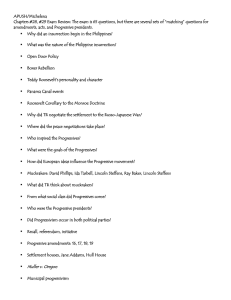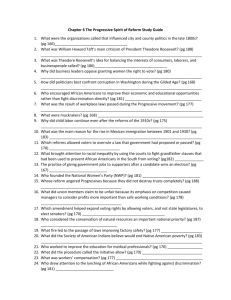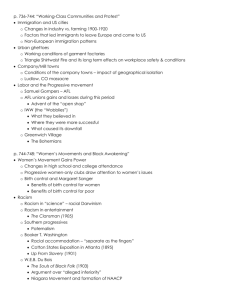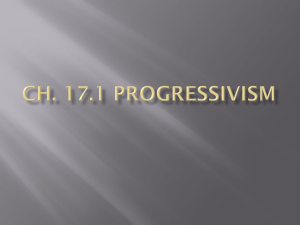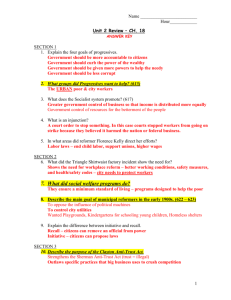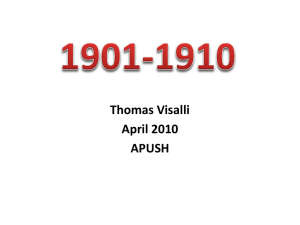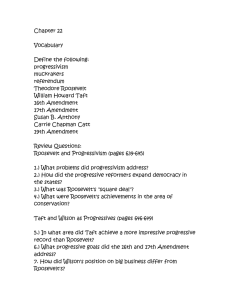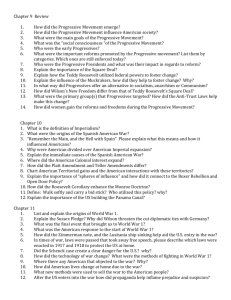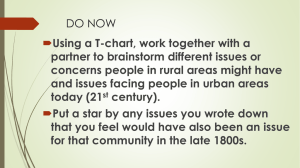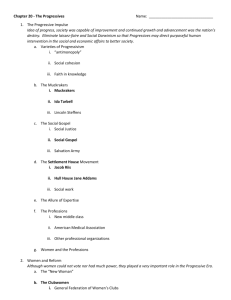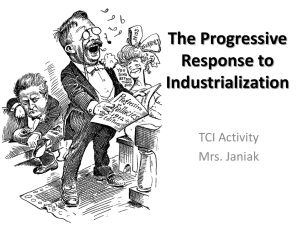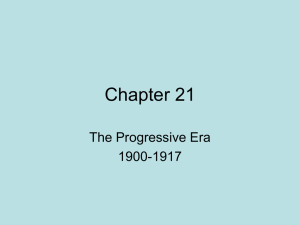Goal 7 The Progressive Movement in the United States (1890
advertisement
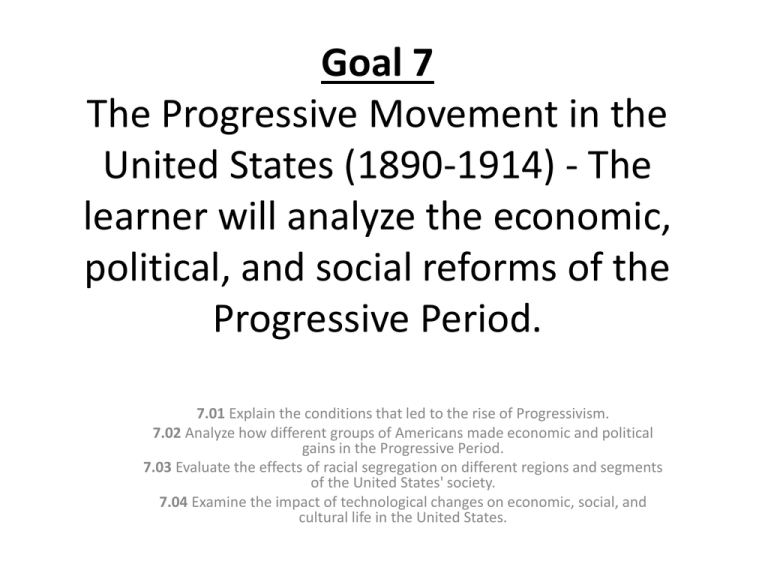
Goal 7 The Progressive Movement in the United States (1890-1914) - The learner will analyze the economic, political, and social reforms of the Progressive Period. 7.01 Explain the conditions that led to the rise of Progressivism. 7.02 Analyze how different groups of Americans made economic and political gains in the Progressive Period. 7.03 Evaluate the effects of racial segregation on different regions and segments of the United States' society. 7.04 Examine the impact of technological changes on economic, social, and cultural life in the United States. Station 1 p 416-418 1. What did Progressives believe in? 2. What did Progressives believe had created social and political problems? 3. How was the Progressive movement similar to the Populist Movement? How were they different? 4. What are some examples of municipal services? Who often controlled them? 5. Why was “trust busting” a goal of Progressives? 6. What were some of the goals of Progressives? What topics did muckrakers cover? 7. What did Lincoln Steffens expose? Station 2 p 418-423 8. Describe the work of Jacob Riis, Ida Tarbell, Upton Sinclair, Frances Watkins 9. Define Social Gospel. 10.Describe the work of Florence Kelley and John Dewey. 11.What changes occurred following the Triangle Shirtwaist Factory fire? 12.Define direct primary, initiative, referendum and recall. 13.Describe the work of Robert La Follette. 14.Which Progressives later became presidents? Station 3 p425-430 15.What were some of the industrial challenges unique to women? 16.What was the ruling of Muller v. Oregon. 17.What role did Florence Kelley play in women’s rights? 18.What were the goals of the WCTU? 19.Describe the works of Margaret Sanger, Ida B Wells, Susan B Anthony, and Carrie Catt. 20.What strategies did women use to gain suffrage? 21.How did WWI impact their efforts? 22. When did women gain suffrage? Station 4 p432-435 23.Define Americanization. 24.How did “scientific” theories fuel nativism? 25.What was the result of Plessy v. Ferguson. 26.Decsribe the works of Booker T. Washington and WEB Dubois. 27.What is the Niagara Movement? 28.Describe the causes of the Springfield Riot. 29.What were/are the goals of the NAACP? 30.What issue did Ida B Wells address? 31.What was the Urban League? Station 5 p435-436 32.What minority groups other than African Americans faced discrimination? 33.What was the Anti-Defamation League? 34.What was the Partido Liberal Mexicano? 35.Define mutualistas. 36.Describe the works of Octaviano Larrazola, Carlos Montezuma and Takao Ozawa. 37.How did federal legislation conflict with native cultures? 38.What were challenges unique to Asian Americans? Station 6 p437-440 39.Describe the Progressive efforts of Theodore Roosevelt. 40.What is the Square Deal? 41.How does Roosevelt impact the railroad industry. 42.Define the ICC Hepburn Act. 43.How did Roosevelt impact trusts? 44.Define the Meat Inspection Act and the Pure Food and Drug Act. 45.What were their causes and effects? Station 7 p440-443 46.Define the FDA. 47.Describe the work of John Muir and Gifford Pinchot. 48.What changes does Roosevelt make to water usage policies? 49.Define the National Reclamation Act. 50.How did Taft and Roosevelt differ? 51.In what ways did Taft undo Roosevelt’s reforms? 52.Define New Nationalism and Progressive Party. Station 8 p444-448 53. In what ways was Woodrow Wilson a Progressive president? 54. Define New Freedom. 55. Define 16th Amendment. 56. Define Federal Reserve Act, Federal Trade Commission. 57. How did the Clayton Anti-trust Act differ from the Sherman? 58. What was the Ludlow Massacre? 59. What were the lasting legacies of Progressivism? 60. What are some challenges resulting from industrialization and urbanization that still need to be addressed?
